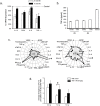4-(Nitrophenylsulfonyl)piperazines mitigate radiation damage to multiple tissues
- PMID: 28732024
- PMCID: PMC5521796
- DOI: 10.1371/journal.pone.0181577
4-(Nitrophenylsulfonyl)piperazines mitigate radiation damage to multiple tissues
Abstract
Our ability to use ionizing radiation as an energy source, as a therapeutic agent, and, unfortunately, as a weapon, has evolved tremendously over the past 120 years, yet our tool box to handle the consequences of accidental and unwanted radiation exposure remains very limited. We have identified a novel group of small molecule compounds with a 4-nitrophenylsulfonamide (NPS) backbone in common that dramatically decrease mortality from the hematopoietic acute radiation syndrome (hARS). The group emerged from an in vitro high throughput screen (HTS) for inhibitors of radiation-induced apoptosis. The lead compound also mitigates against death after local abdominal irradiation and after local thoracic irradiation (LTI) in models of subacute radiation pneumonitis and late radiation fibrosis. Mitigation of hARS is through activation of radiation-induced CD11b+Ly6G+Ly6C+ immature myeloid cells. This is consistent with the notion that myeloerythroid-restricted progenitors protect against WBI-induced lethality and extends the possible involvement of the myeloid lineage in radiation effects. The lead compound was active if given to mice before or after WBI and had some anti-tumor action, suggesting that these compounds may find broader applications to cancer radiation therapy.
Conflict of interest statement
Figures







Similar articles
-
The Aftermath of Surviving Acute Radiation Hematopoietic Syndrome and its Mitigation.Radiat Res. 2019 Apr;191(4):323-334. doi: 10.1667/RR15231.1. Epub 2019 Feb 7. Radiat Res. 2019. PMID: 30730284 Free PMC article.
-
Classes of Drugs that Mitigate Radiation Syndromes.Front Pharmacol. 2021 May 18;12:666776. doi: 10.3389/fphar.2021.666776. eCollection 2021. Front Pharmacol. 2021. PMID: 34084139 Free PMC article.
-
Bilirubin augments radiation injury and leads to increased infection and mortality in mice: molecular mechanisms.Free Radic Biol Med. 2012 Sep 1;53(5):1152-69. doi: 10.1016/j.freeradbiomed.2012.07.007. Epub 2012 Jul 20. Free Radic Biol Med. 2012. PMID: 22819982
-
Combined mitigation of the gastrointestinal and hematopoietic acute radiation syndromes by an LPA2 receptor-specific nonlipid agonist.Chem Biol. 2015 Feb 19;22(2):206-16. doi: 10.1016/j.chembiol.2014.12.009. Epub 2015 Jan 22. Chem Biol. 2015. PMID: 25619933 Free PMC article.
-
Tumor apoptosis induced by epoxide-containing piperazines, a new class of anti-cancer agents.Cancer Chemother Pharmacol. 2000;45(3):183-91. doi: 10.1007/s002800050028. Cancer Chemother Pharmacol. 2000. PMID: 10663635
Cited by
-
The Aftermath of Surviving Acute Radiation Hematopoietic Syndrome and its Mitigation.Radiat Res. 2019 Apr;191(4):323-334. doi: 10.1667/RR15231.1. Epub 2019 Feb 7. Radiat Res. 2019. PMID: 30730284 Free PMC article.
-
1-(4-nitrobenzenesulfonyl)-4-penylpiperazine increases the number of Peyer's patch-associated regenerating crypts in the small intestines after radiation injury.Radiother Oncol. 2019 Mar;132:8-15. doi: 10.1016/j.radonc.2018.11.011. Epub 2018 Dec 20. Radiother Oncol. 2019. PMID: 30825974 Free PMC article.
-
STING directly interacts with PAR to promote apoptosis upon acute ionizing radiation-mediated DNA damage.Cell Death Differ. 2025 Jun;32(6):1167-1179. doi: 10.1038/s41418-025-01457-z. Epub 2025 Feb 12. Cell Death Differ. 2025. PMID: 39939798 Free PMC article.
-
Radiation mitigation of the intestinal acute radiation injury in mice by 1-[(4-nitrophenyl)sulfonyl]-4-phenylpiperazine.Stem Cells Transl Med. 2020 Jan;9(1):106-119. doi: 10.1002/sctm.19-0136. Epub 2019 Aug 29. Stem Cells Transl Med. 2020. PMID: 31464098 Free PMC article.
-
Classes of Drugs that Mitigate Radiation Syndromes.Front Pharmacol. 2021 May 18;12:666776. doi: 10.3389/fphar.2021.666776. eCollection 2021. Front Pharmacol. 2021. PMID: 34084139 Free PMC article.
References
-
- Frantz MC, Skoda EM, Sacher JR, Epperly MW, Goff JP, Greenberger JS, et al. Synthesis of analogs of the radiation mitigator JP4-039 and visualization of BODIPY derivatives in mitochondria. Org Biomol Chem. 2013;11(25): 4147–4153. doi: 10.1039/c3ob40489g - DOI - PMC - PubMed
-
- Wang X, Wei L, Cramer JM, Leibowitz BJ, Judge C, Epperly M, et al. Pharmacologically blocking p53-dependent apoptosis protects intestinal stem cells and mice from radiation. Sci Rep. 2015;5: 8566 doi: 10.1038/srep08566 - DOI - PMC - PubMed
-
- Burdelya LG, Krivokrysenko VI, Tallant TC, Strom E, Gleiberman AS, Gupta D, et al. An agonist of toll-like receptor 5 has radioprotective activity in mouse and primate models. Science. 2008;320(5873): 226–230. doi: 10.1126/science.1154986 - DOI - PMC - PubMed
-
- Shakhov AN, Singh VK, Bone F, Cheney A, Kononov Y, Krasnov P, et al. Prevention and mitigation of acute radiation syndrome in mice by synthetic lipopeptide agonists of Toll-like receptor 2 (TLR2). PLoS One. 2012;7(3): e33044 doi: 10.1371/journal.pone.0033044 - DOI - PMC - PubMed
MeSH terms
Substances
Grants and funding
LinkOut - more resources
Full Text Sources
Other Literature Sources
Research Materials
Miscellaneous

